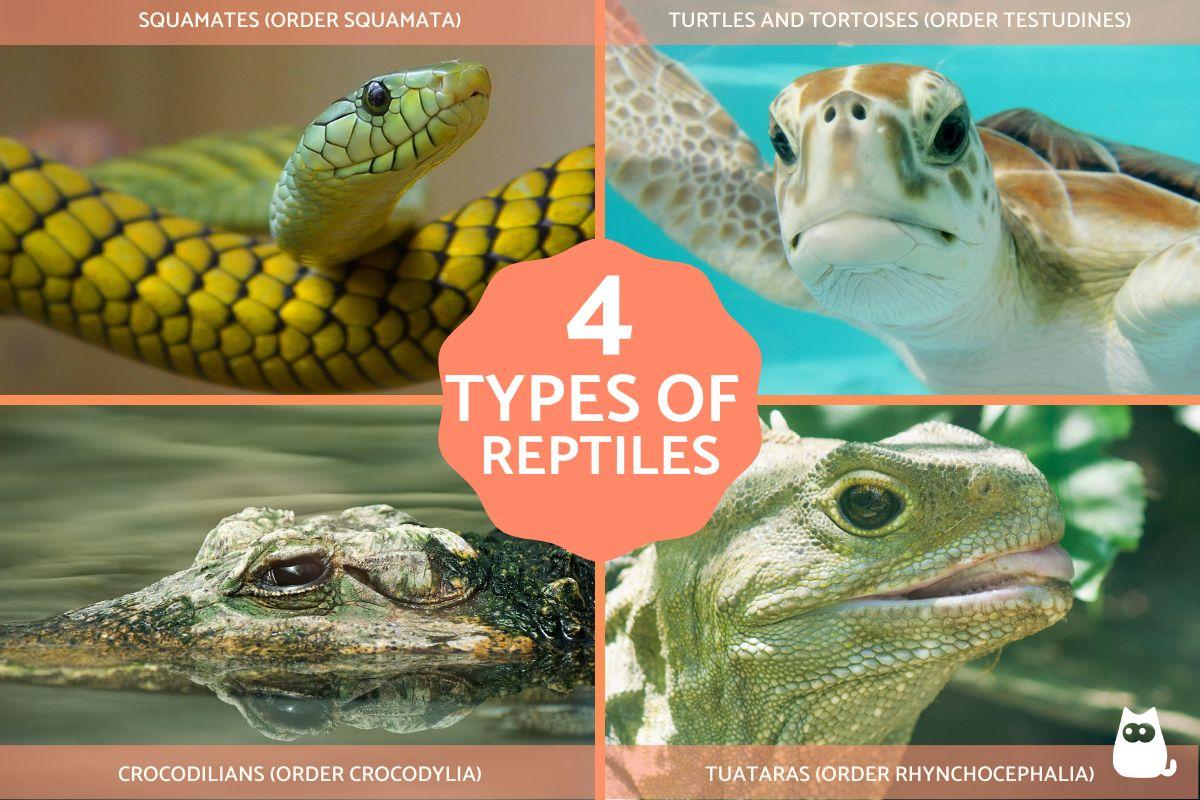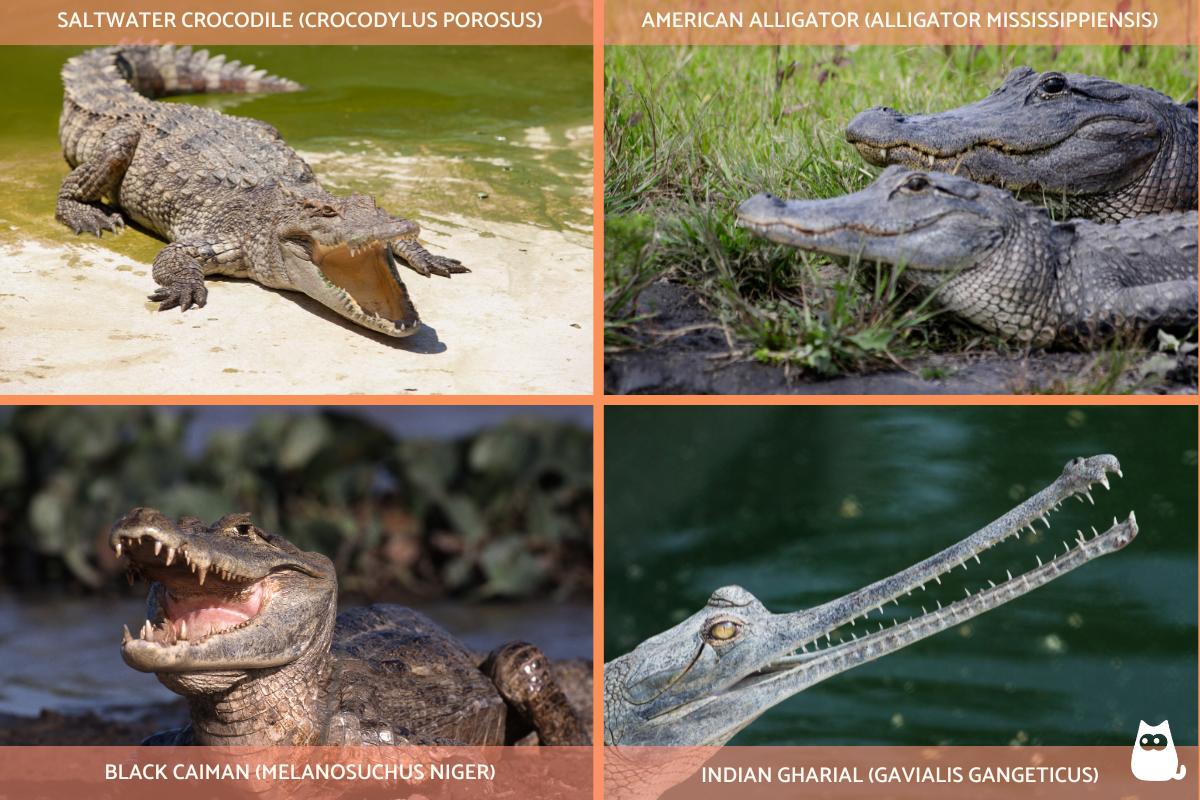What Are the Types of Reptiles?


Reptiles are some of the most diverse and ancient creatures on Earth, thriving in nearly every environment—from scorching deserts to dense rainforests. As cold-blooded vertebrates, they rely on their surroundings to regulate body temperature, and their unique adaptations have allowed them to survive for millions of years.
In this AnimalWised article, we'll explore the four major types of reptiles, breaking down their characteristics, habitats, and notable species.
What are reptiles?
Reptiles are ectothermic vertebrates, which essentially means that they are cold-blooded animals with backbones that cannot produce significant body heat internally.
They depend on external heat sources to regulate their body temperature. This fundamental trait determines reptile behavior and distribution patterns. Unlike endothermic animals (mammals and birds) that maintain constant internal temperatures, reptiles must move between sunny and shaded locations to achieve their preferred temperature range.
This thermoregulatory behavior allows reptiles to use less energy when inactive but requires external heat for essential functions like digestion, movement, and reproduction. Ectothermy creates both benefits and limitations. On the one hand, reptiles consume significantly less food than comparable-sized mammals but, on the other, they cannot remain active during cold periods or in cold regions.
What is the difference between reptiles and amphibians?
Reptiles and amphibians are different classes of vertebrates, with reptiles representing an evolutionary advancement in adaptation to land environments.
Three primary differences distinguish these groups: skin structure, reproductive strategy, and life cycle. Reptiles possess dry, keratinized scales that prevent dehydration, while amphibians have smooth, permeable skin that supports cutaneous respiration (breathing through skin).
The most significant evolutionary innovation is the amniotic egg. Reptiles produce eggs with specialized membranes (amnion, chorion, and allantois) and protective shells that maintain moisture and provide nutrients, enabling fully terrestrial reproduction. Amphibians typically lay unshelled eggs in water, and their young develop through metamorphosis. Additionally, reptiles possess more developed pulmonary and circulatory systems, with complete lungs rather than the dual lung/skin respiration of many amphibians.
Wonder how frogs and salamanders compare to the reptiles in this article? Check out our companion piece on the fascinating differences between these animal groups.
How are reptiles classified?
The fossil record indicates that reptiles first appeared approximately 315 million years ago during the late Carboniferous period. The earliest reptiles diverged from amphibian ancestors following the evolution of the amniotic egg, which permitted colonization of drier habitats. The Mesozoic Era (252-66 million years ago), often termed the "Age of Reptiles," saw reptiles become the dominant terrestrial vertebrates.
Modern reptiles represent only a small portion of their historical diversity. After the Cretaceous-Paleogene extinction event 66 million years ago that eliminated non-avian dinosaurs, mammals became the predominant land vertebrates, while surviving reptile groups continued to adapt and evolve. Modern biologists now understand that birds evolved from reptilian ancestors (specifically, theropod dinosaurs). This means that from an evolutionary perspective, birds could technically be considered specialized reptiles, though for practical purposes, they are still classified separately.
This evolutionary history has shaped how scientists classify reptiles today. Based on anatomical features, genetic relationships, and evolutionary development, taxonomists have organized living reptiles into four distinct orders.
Each order represents a separate evolutionary lineage that has developed unique adaptations over millions of years. These classification groups help scientists understand the relationships between different reptile species and track their evolutionary paths from ancient ancestors. While the traditional classification system continues to evolve as new genetic evidence emerges, the four-order system provides a practical framework for studying the major reptile groups alive today.
- Squamates (Order Squamata): is the largest reptile order includes all snakes and lizards. Characterized by overlapping scales and unique jaw structures that allow greater mouth mobility, squamates have successfully adapted to diverse habitats worldwide.
- Turtles and tortoises (Order Testudines): they are instantly recognizable by their protective shells fused to their skeleton, these reptiles have changed little over millions of years. Their unique body plan includes a bony carapace and plastron.
- Crocodilians (Order Crocodylia): these semi-aquatic predators include crocodiles, alligators, caimans, and gharials. They share armored skin, powerful jaws, and uniquely, a four-chambered heart similar to mammals.
- Tuataras (Order Rhynchocephalia): found only in New Zealand, these living fossils represent the last survivors of an ancient lineage. They resemble lizards but possess distinctive anatomical features including a unique jaw structure and a parietal "third eye."
This classification system helps scientists organize the approximately 10,000 species of reptiles alive today, making it easier to study their relationships and characteristics. Curious about how these ancient creatures take a breath? Dive deeper into the respiratory adaptations of reptiles in our companion article.
Squamates (Order Squamata)
The order Squamata represents the largest and most diverse group of reptiles, comprising over 10,000 species, which is approximately 95% of all living reptile species. The name "Squamata" derives from the Latin word for "scaly," referring to their characteristic overlapping scales.
Key characteristics of squamata:
- Movable quadrate bone: this skull modification allows for greater jaw mobility, enabling many squamates to swallow prey larger than their heads.
- Skin structure: their bodies are covered with overlapping epidermal scales made of keratin, which they shed periodically (ecdysis) as they grow.
- Skull kinesis: many possess a skull with movable joints, increasing feeding flexibility.
- Paired copulatory organs: males have paired hemipenes rather than a single penis.
Classification of squamata:
This highly successful order includes three major subgroups: snakes (suborder Serpentes), lizards (suborder Lacertilia), and worm lizards (suborder Amphisbaenia).
- Snakes evolved from lizard ancestors, losing their limbs and developing specialized anatomical features for their predatory lifestyle. Their extremely flexible jaws and elongated bodies allow them to consume large prey whole. Some species have developed potent venoms delivered through modified teeth, while others kill by constriction.
- Lizards show incredible variation in size, from tiny geckos measuring just a few centimeters to the Komodo dragon reaching three meters in length. They have adapted to almost every terrestrial habitat, from deserts to rainforests. Many species can detach their tails when threatened (caudal autotomy), a defensive adaptation that allows escape from predators.
- Worm lizards are highly specialized burrowers with cylindrical bodies, reduced eyes, and reinforced skulls for digging. Their segmented appearance and subterranean lifestyle have evolved independently from snakes through convergent evolution.
Examples of squamata:
- Venomous snakes: species like the King cobra (Ophiophagus hannah) and Eastern diamondback rattlesnake (Crotalus adamanteus) possess specialized venom glands and modified teeth for delivering toxins.
- Constrictor snakes: the Reticulated python (Python reticulatus) and Boa constrictor (Boa constrictor) kill prey by wrapping around and squeezing it, restricting blood flow and respiration.
- Iguanas: the Marine iguana (Amblyrhynchus cristatus) of the Galápagos can dive and feed underwater, while the Green iguana (Iguana iguana) is arboreal and herbivorous.
- Geckos: the Tokay gecko (Gekko gecko) has specialized toe pads that allow it to climb smooth vertical surfaces and even walk across ceilings.
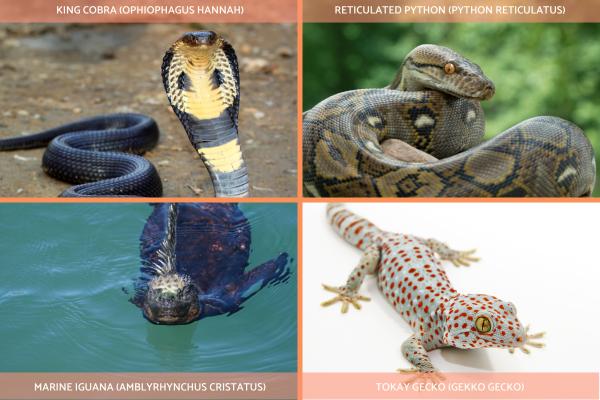
Turtles and tortoises (Order Testudines)
The order Testudines, comprising approximately 360 species of turtles and tortoises, represents one of the most ancient and recognizable reptile lineages, having existed for over 220 million years. The name "Testudines" comes from the Latin word "testudo," meaning "tortoise."
This group is instantly identifiable by its most distinctive feature, which is the protective shell that has remained fundamentally unchanged since the time of dinosaurs.
Key characteristics of testudines:
- Shell structure: their signature shell consists of two parts, an upper shell and a lower shell, connected by bridges on each side. This shell is not an external covering but is fused to their skeleton, incorporating the ribs and vertebrae.
- Toothless jaws: instead of teeth, turtles have sharp, horny beaks adapted for their specific diets.
- Breathing mechanism: because their ribs are fused to the shell, turtles cannot breathe by expanding their ribcage. Instead, they use specialized muscles to pull air into their lungs.
- Anapsid skull: unlike other reptiles, turtles have no temporal openings in their skull, representing a primitive condition.
Classification of Testudines:
Testudines are divided into two major subgroups based on how they retract their necks into their shells:
- Cryptodira (hidden-necked turtles): these turtles pull their necks straight back into their shells by folding them in an S-shape vertically. This group includes most familiar turtles such as sea turtles, snapping turtles, box turtles, and tortoises. They have adapted to diverse habitats from oceans to deserts and vary greatly in size and lifestyle.
- Pleurodira (side-necked turtles): these species bend their necks sideways to tuck them under the edge of their shells. Found primarily in the Southern Hemisphere, this group includes the mata mata, with its distinctive flat, leaf-like appearance, and various freshwater turtles of Africa, Australia, and South America.
Examples of Testudines:
- Sea turtles: with streamlined shells and flipper-like limbs, species like the Green sea turtle (Chelonia mydas) and Leatherback turtle (Dermochelys coriacea) can migrate thousands of miles across oceans.
- Freshwater turtles: Including the Red-eared slider (Trachemys scripta elegans) and Painted turtle (Chrysemys picta), these species have webbed feet and typically inhabit ponds, lakes, and rivers.
- Box turtles: These terrestrial North American turtles (Terrapenespecies) have a hinged plastron that allows them to completely close their shell for protection.
- Tortoises: giant species like the Galápagos tortoise (Chelonoidis nigra) and Aldabra giant tortoise (Aldabrachelys gigantea) have domed shells and can live over 100 years, while smaller species like the Russian tortoise (Testudo horsfieldii) are popular pets.
Did you know there's often confusion about whether turtles belong with reptiles or amphibians? Learn the scientific answer in our related feature article.

Crocodilians (Order Crocodylia)
The order Crocodylia, comprising approximately 24 species of crocodiles, alligators, caimans, and gharials, represents one of the most ancient reptile lineages, having survived for over 200 million years. The name "Crocodylia" derives from the Greek word "krokodilos," meaning "lizard of the Nile."
This group is instantly identifiable by its distinctive body plan that has remained fundamentally unchanged since the time of dinosaurs.
Key characteristics of crocodilians:
- Armored skin: their signature tough, scaled hide features bony plates called osteoderms that provide protection while allowing flexibility.
- Specialized jaws: powerful jaws equipped with numerous conical teeth adapted for gripping prey, with some species exerting the strongest bite force of any living animal.
- Semi-aquatic adaptations: including a laterally compressed tail for swimming, webbed feet, and specialized valve systems that prevent water entry during submersion.
- Diapsid skull: unlike turtles, crocodilians have two temporal openings in their skull, which is the standard reptilian condition.
Classification of Crocodylia:
Crocodilians are divided into three major families based on physical characteristics and evolutionary relationships:
- Crocodylidae (true crocodiles): characterized by a V-shaped snout and visible lower teeth when the mouth is closed. This family includes the Nile crocodile (Crocodylus niloticus) and Saltwater crocodile (Crocodylus porosus), the largest living reptiles.
- Alligatoridae (alligators and caimans): featuring a broader U-shaped snout with lower teeth hidden when the mouth is closed. This group includes the American alligator (Alligator mississippiensis) and various caiman species.
- Gavialidae (gharials): distinguished by their extremely narrow snouts specialized for fish capture. The Indian gharial (Gavialis gangeticus) is critically endangered and has distinctive bulbous growths on the tip of the male's snout.
Examples of Crocodylians:
- Saltwater crocodile: the largest reptile in the world (Crocodylus porosus) can reach over 20 feet in length and is known for its aggressive territorial behavior.
- American alligator: an iconic species (Alligator mississippiensis) of the southeastern United States that can regulate its body temperature by moving between sun and shade.
- Black caiman: this South American species (Melanosuchus niger) is the largest predator in the Amazon ecosystem.
- Indian gharial: With its distinctive needle-like snout (Gavialis gangeticus), this specialized fish-eater is among the most endangered crocodilians, with fewer than 1,000 adults remaining in the wild.
Did you know that reptiles have evolved some truly remarkable reproductive adaptations? Learn about their diverse breeding strategies in our detailed companion piece.
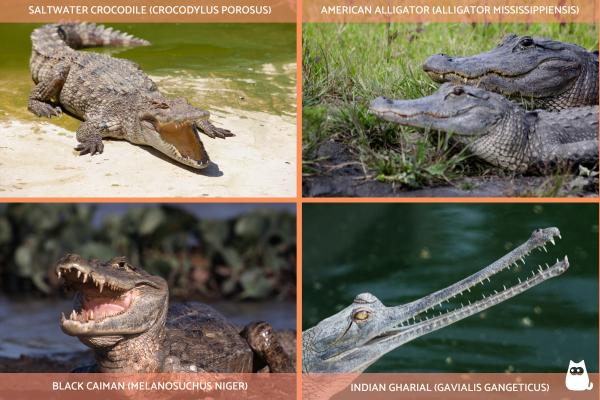
Tuataras (Order Rhynchocephalia)
The order Rhynchocephalia, currently represented by only 2 living species of tuataras, is one of the most ancient reptile lineages, having existed for over 250 million years. The name "Rhynchocephalia" comes from Greek words meaning "beak head," referring to their distinctive snout shape.
This group is remarkable for being a living fossil, with modern tuataras resembling their prehistoric ancestors that thrived during the time of dinosaurs.
Key characteristics of tuataras:
- Third eye: tuataras have a parietal eye (or "third eye") on top of their heads, complete with a lens and retina. While not used for vision, this photosensitive organ helps regulate circadian rhythms and hormone production.
- Unique dentition: unlike true lizards, their teeth are fused directly to the jawbone. They have a distinctive single row of teeth on the jawbone and two rows on the upper palate.
- Primitive vertebrae: they possess biconcave vertebrae, a primitive feature not found in other living reptiles.
- Slow metabolism: tuataras have the slowest growth rate of any reptile, reaching sexual maturity at 15-20 years and living up to 100 years or more.
Classification of Rhynchocephalia:
While historically diverse, the order Rhynchocephalia is now reduced to a single family:
Sphenodontidae: this family contains only the genus Sphenodon, with two recognized species: Sphenodon punctatus (northern tuatara) and Sphenodon guntheri (Brothers Island tuatara), though recent genetic studies have questioned this distinction. Once widespread globally, tuataras are now restricted to small islands off the coast of New Zealand.
Interested in reptile evolution? Check out our article on the reptiles that once lived in ancient oceans.
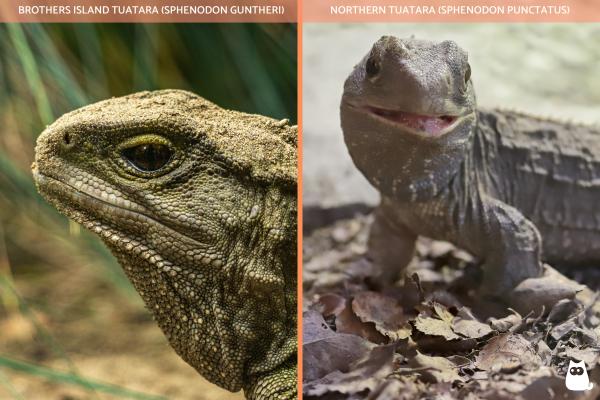
If you want to read similar articles to What Are the Types of Reptiles?, we recommend you visit our Facts about the animal kingdom category.
- Hedges, S. B. (2014). The high-level classification of skinks (Reptilia, Squamata, Scincomorpha). Zootaxa, 3765(4), 317-338.
- Herrera‐Flores, JA, Stubbs, TL, & Benton, MJ (2017). Macroevolutionary patterns in Rhynchocephalia: is the tuatara (Sphenodon punctatus) a living fossil?. Palaeontology, 60(3), 319-328.
- Kardong, K. V. (2006). Vertebrates: comparative anatomy, function, evolution (pp. 365-383). New York: McGraw-Hill.





